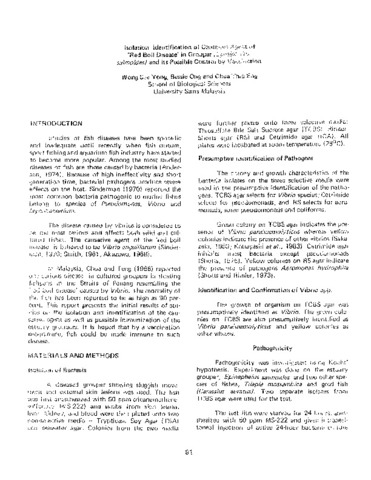Identification of a chromosomally-encoded sucrose operon-like gene cluster in Vibrio parahaemolyticus strain PH05 isolated from Negros Island, Philippines
- Global styles
- MLA
- Vancouver
- Elsevier - Harvard
- APA
- Help

Download URL
www.biorxiv.orgDate
2021-02-27Page views
667ASFA keyword
AGROVOC keyword
Taxonomic term
Geographic names
Metadata
Show full item record
Share
Abstract
The ability of bacteria to metabolize a wide variety of carbon sources has been known to aid in their ability for efficient colonization. Vibrio parahaemolyticus, a known aquatic pathogen has been reported to have the ability to metabolize a number of carbohydrates including D-glucose, D-galactose, L-arabinose, D-mannose, and D-ribose to name a few. Classical isolation of V. parahaemolyticus from other members of the family Vibrionaceae relies on its carbon utilization pattern. Conventionally, V. parahaemolyticus lacks the ability to utilize sucrose and this has been the basis for its isolation using the Thiosulfate-citrate-bile salts-sucrose (TCBS) agar. Reports of V. parahaemolyticus having the ability to utilize sucrose have been presented yet there is paucity of information and detailed study on this phenotype. In this study, we report the V. parahaemolyticus strain PH05 that has the ability to metabolize sucrose. Phenotypic and genotypic characterization of this V. parahaemolyticus strain isolated from Negros Island, Philippines, revealed that V. parahaemolyticus strain PH05 is atypical appearing yellow on TCBS agar plates. It is capable of utilizing sucrose, unlike the majority of V. parahaemolyticus isolates. Genome analyses of this strain revealed the presence of a chromosomally encoded sucrose operon-like gene cluster encoded in chromosome 2 with the following sucrose-utilization associated genes: scrY, ccpA, treP, scrK, and scrB genes coding for sucrose porin, catabolite control protein A, PTS System sucrose-specific EIIBC component, fructokinase, and sucrose-6-phosphate hydrolase. The mode of transmission of these genes to V. parahaemolyticus strain PH05 is still unknown. However, the presence of insertion sequences (IS) and phage elements in the same chromosome suggests horizontal gene transfer events. Taken together, our results point to the possibility that acquired sucrose utilization genes may contribute to the fitness of V. parahaemolyticus strain PH05 in the environment.
Suggested Citation
De Mesa, C. A. E., Mendoza, R. M., Amar, E. C., de la Peña, L. D., & Saloma, C. P. (2021). Identification of a chromosomally-encoded sucrose operon-like gene cluster in Vibrio parahaemolyticus strain PH05 isolated from Negros Island, Philippines [Preprint]. bioRxiv. https://doi.org/10.1101/2021.02.27.433172
Type
PreprintCollections
- Journal Articles [1258]
Related items
Showing items related by title, author, creator and subject.
-
Studies on the efficacy of Sarafin® (sarafloxacin hydrochloride) on vibrios associated with vibriosis in black tiger shrimp (Penaeus monodon)
Pakingking, Rolando V., Jr. ; Lacierda, Erlinda; Torres, James L. (Fish Health Section, Asian Fisheries Society, 2002)
In vitro activity of Sarafin® (sarafloxacin hydrochloride) was determined against 7 luminous Vibrio harveyi isolates and 3 non-luminous Vibrio species (V. parahaemolyticus, V. alginolyticus and Vibrio species) isolated ...
; Lacierda, Erlinda; Torres, James L. (Fish Health Section, Asian Fisheries Society, 2002)
In vitro activity of Sarafin® (sarafloxacin hydrochloride) was determined against 7 luminous Vibrio harveyi isolates and 3 non-luminous Vibrio species (V. parahaemolyticus, V. alginolyticus and Vibrio species) isolated ... -
Occurrence of Vibrio sp. infection in grouper, Epinephelus suillus
Lavilla-Pitogo, Celia R.; Castillo, A. R.; de la Cruz, Margarita C. (Blackwell Publishing, 1992)Vibrio sp., was consistently isolated from grouper, Epinephelus suillus, with bacterial infection. Fingerlings, which were challenged with the bacterium by injection, were highly susceptible. Immersion challenge resulted ... -
Isolation, identification of causative agent of "red boil disease" in grouper (Epinephelus salmoides) and its possible control by vaccination
Wong, See-Yong; Ong, Bessie; Chua, Thia-Eng (Aquaculture Department, Southeast Asian Fisheries Development Center; International Development Research Centre, 1979)This report presents the initial results of studies on the isolation and identification of the causative agent as well as possible immunization of the estuary groupers. It is hoped that by a vaccination programme, fish ...






